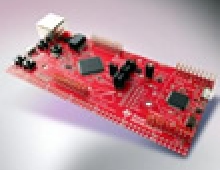
TI Releases OMAP 5 Platform For Mobile Devices
Texas Instruments announced today the next generation of its OMAP family: the OMAP 5 mobile applications platform.
The chip will give users more versatility in how they use their cellphones, helping it to compete better with rivals including Qualcomm and Nvidia.
The 28 nanometer OMAP 5 applications processors carry on the OMAP family tradition of delivering significant increases in performance and functionality, while lowering power consumption compared to their predecessors. Specifically, they offer up to 3x processing performance and five-fold 3D graphics improvement, yet provide a nearly 60 percent average power reduction compared to a sample user experience on the OMAP 4 platform. Additionally, the OMAP 5 platform's software is designed for maximum reuse to ease migration from the OMAP 4 platform.
The OMAP 5 processor leverages two ARM Cortex-A15 MPCores capable of speeds of up to 2 GHz per core in the OMAP 5 implementation. The new cores offer a 50 percent boost in performance over the Cortex-A9 core (at the same clock frequency). Combined with up to 8GB of dynamic memory access and hardware virtualization support, the Cortex-A15 core can enable very high peformance.
The OMAP 5 architecture utilizes an intelligent combination of many different processing cores ? each tailored and power-optimized for specific functions. In addition to the two Cortex-A15 cores, the OMAP 5 processor includes individual, dedicated engines for: video, imaging and vision, DSP, 3D graphics, 2D graphics, display and security. The processor also includes two ARM Cortex-M4 processors for offloading real-time processing from the Cortex-A15 cores to improve low-level control and responsiveness of mobile devices.
Natural user interfaces (NUI) ? how we interact with the world around us in a natural way ? are taken to the next level with the OMAP 5 platform's support for S3D, gesturing (including proximity sensing), and interactive projection.
The OMAP 5 processor can support up to four cameras in parallel, as well as record and play back S3D video in 1080p quality, and perform real-time conversion of 2D content to S3D at 1080p resolution. The new processor can also deliver advanced short- and long-range gesturing applications, as well as full-body and multi-body interactive gestures, utilizing either 2D or S3D cameras. The OMAP 5 processor, coupled with a TI DLP Pico projector and a camera, can also enable interactive projection where the user can actually "touch and drag" projected images on both a table top or wall.
Additionally, the OMAP 5 processor can interface with and leverage a wide variety of sensor technologies to enable touchless sensing, such as proximity sensing, capacitive sensing and ultrasonic sensing.
The OMAP 5 processor also includes hardware and software resources that enable the development and deployment of computational algorithms used to compensate the limitations of the built-in cameras found in mobile devices, compared to digital SLR cameras. These algorithms include camera stabilization, motion blur reduction, noise reduction, high dynamic range and face-based processing. The new processor also goes a step further by using the same OMAP 5 hardware resources with vision algorithms to extract features and data from the picture, in order to implement applications such as face recognition, object recognition and text recognition.
The OMAP 5 platform the following list of features:
- Two ARM Cortex-A15 cores, up to 2 GHz each: 3x higher performance to deliver the promise of mobile computing
- Two ARM Cortex-M4 cores: Low-power offload and real-time responsiveness
- Multi-core 3D graphics and dedicated 2D graphics: 5x higher graphics performance; accelerated and more responsive user interfaces
- Multi-core imaging and vision processing unit: Next-generation computational photography experiences ? face recognition, object recognition and text recognition
- Multi-core IVA HD video engine: 1080p60 HD video and high performance, low bit rate video teleconferencing
- Advanced, multi-pipeline display sub-system: Supports multiple video/graphics sources for composition
- Can support four simultaneous displays: Supports three high-resolution LCD displays (up to QSXGA) and HDMI 1.4a 3D display
- High performance, multi-channel DRAM and efficient 2D memory support: Supports advanced use cases with multiple ARM cores and multimedia operation; provides better user experiences without lag or quality degradation
- TI M-Shield mobile security technology with enhanced cryptography support: End-to-end device and content protection
- New, high-speed interfaces: Supports USB 3.0 OTG, SATA 2.0, SDXC flash memory and MIPI CSI-3, UniPort-M and LLI interfaces to support higher Wi-Fi and 4G network and HD content data rates
- Optimized audio, power and battery management platform solutions: Complementary TI devices for an optimized OMAP 5 platform solution
- Next-generation connectivity technologies: HD wireless video streaming, wireless display, mobile payments and enhanced location-based services
TI's OMAP 5 platform is expected to sample in the second half of 2011, with devices on the market in the second half of 2012. The OMAP5430 processor is offered in a 14x14mm Package-on-Package (PoP) with LPDDR2 memory support. The OMAP5432 processor is offered in a 17x17mm BGA package with DDR3/DDR3L memory support.
These products are intended for high-volume mobile OEMs and ODMs and are not available through distributors. TI also plans to develop compatible ARM Cortex-A15 processor-based solutions for broader market applications across TI's product portfolio.
The 28 nanometer OMAP 5 applications processors carry on the OMAP family tradition of delivering significant increases in performance and functionality, while lowering power consumption compared to their predecessors. Specifically, they offer up to 3x processing performance and five-fold 3D graphics improvement, yet provide a nearly 60 percent average power reduction compared to a sample user experience on the OMAP 4 platform. Additionally, the OMAP 5 platform's software is designed for maximum reuse to ease migration from the OMAP 4 platform.
The OMAP 5 processor leverages two ARM Cortex-A15 MPCores capable of speeds of up to 2 GHz per core in the OMAP 5 implementation. The new cores offer a 50 percent boost in performance over the Cortex-A9 core (at the same clock frequency). Combined with up to 8GB of dynamic memory access and hardware virtualization support, the Cortex-A15 core can enable very high peformance.
The OMAP 5 architecture utilizes an intelligent combination of many different processing cores ? each tailored and power-optimized for specific functions. In addition to the two Cortex-A15 cores, the OMAP 5 processor includes individual, dedicated engines for: video, imaging and vision, DSP, 3D graphics, 2D graphics, display and security. The processor also includes two ARM Cortex-M4 processors for offloading real-time processing from the Cortex-A15 cores to improve low-level control and responsiveness of mobile devices.
Natural user interfaces (NUI) ? how we interact with the world around us in a natural way ? are taken to the next level with the OMAP 5 platform's support for S3D, gesturing (including proximity sensing), and interactive projection.
The OMAP 5 processor can support up to four cameras in parallel, as well as record and play back S3D video in 1080p quality, and perform real-time conversion of 2D content to S3D at 1080p resolution. The new processor can also deliver advanced short- and long-range gesturing applications, as well as full-body and multi-body interactive gestures, utilizing either 2D or S3D cameras. The OMAP 5 processor, coupled with a TI DLP Pico projector and a camera, can also enable interactive projection where the user can actually "touch and drag" projected images on both a table top or wall.
Additionally, the OMAP 5 processor can interface with and leverage a wide variety of sensor technologies to enable touchless sensing, such as proximity sensing, capacitive sensing and ultrasonic sensing.
The OMAP 5 processor also includes hardware and software resources that enable the development and deployment of computational algorithms used to compensate the limitations of the built-in cameras found in mobile devices, compared to digital SLR cameras. These algorithms include camera stabilization, motion blur reduction, noise reduction, high dynamic range and face-based processing. The new processor also goes a step further by using the same OMAP 5 hardware resources with vision algorithms to extract features and data from the picture, in order to implement applications such as face recognition, object recognition and text recognition.
The OMAP 5 platform the following list of features:
- Two ARM Cortex-A15 cores, up to 2 GHz each: 3x higher performance to deliver the promise of mobile computing
- Two ARM Cortex-M4 cores: Low-power offload and real-time responsiveness
- Multi-core 3D graphics and dedicated 2D graphics: 5x higher graphics performance; accelerated and more responsive user interfaces
- Multi-core imaging and vision processing unit: Next-generation computational photography experiences ? face recognition, object recognition and text recognition
- Multi-core IVA HD video engine: 1080p60 HD video and high performance, low bit rate video teleconferencing
- Advanced, multi-pipeline display sub-system: Supports multiple video/graphics sources for composition
- Can support four simultaneous displays: Supports three high-resolution LCD displays (up to QSXGA) and HDMI 1.4a 3D display
- High performance, multi-channel DRAM and efficient 2D memory support: Supports advanced use cases with multiple ARM cores and multimedia operation; provides better user experiences without lag or quality degradation
- TI M-Shield mobile security technology with enhanced cryptography support: End-to-end device and content protection
- New, high-speed interfaces: Supports USB 3.0 OTG, SATA 2.0, SDXC flash memory and MIPI CSI-3, UniPort-M and LLI interfaces to support higher Wi-Fi and 4G network and HD content data rates
- Optimized audio, power and battery management platform solutions: Complementary TI devices for an optimized OMAP 5 platform solution
- Next-generation connectivity technologies: HD wireless video streaming, wireless display, mobile payments and enhanced location-based services
TI's OMAP 5 platform is expected to sample in the second half of 2011, with devices on the market in the second half of 2012. The OMAP5430 processor is offered in a 14x14mm Package-on-Package (PoP) with LPDDR2 memory support. The OMAP5432 processor is offered in a 17x17mm BGA package with DDR3/DDR3L memory support.
These products are intended for high-volume mobile OEMs and ODMs and are not available through distributors. TI also plans to develop compatible ARM Cortex-A15 processor-based solutions for broader market applications across TI's product portfolio.




















